Dave Zhenyu Chen
Does Your 3D Encoder Really Work? When Pretrain-SFT from 2D VLMs Meets 3D VLMs
Jun 06, 2025

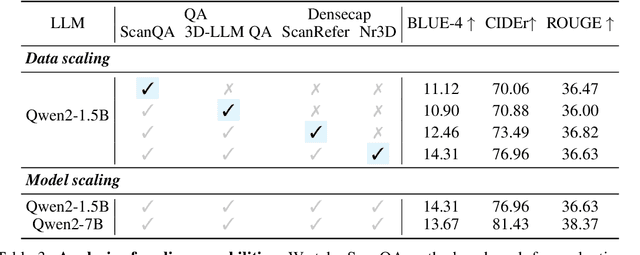
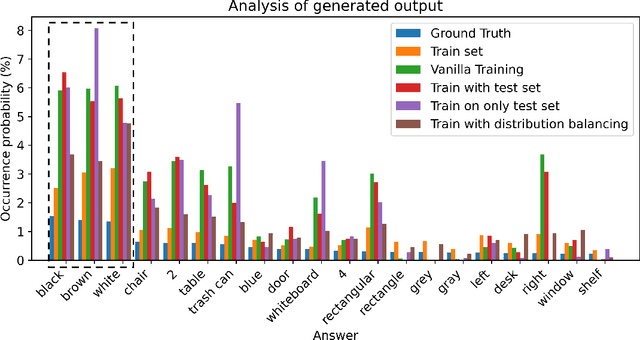
Abstract:Remarkable progress in 2D Vision-Language Models (VLMs) has spurred interest in extending them to 3D settings for tasks like 3D Question Answering, Dense Captioning, and Visual Grounding. Unlike 2D VLMs that typically process images through an image encoder, 3D scenes, with their intricate spatial structures, allow for diverse model architectures. Based on their encoder design, this paper categorizes recent 3D VLMs into 3D object-centric, 2D image-based, and 3D scene-centric approaches. Despite the architectural similarity of 3D scene-centric VLMs to their 2D counterparts, they have exhibited comparatively lower performance compared with the latest 3D object-centric and 2D image-based approaches. To understand this gap, we conduct an in-depth analysis, revealing that 3D scene-centric VLMs show limited reliance on the 3D scene encoder, and the pre-train stage appears less effective than in 2D VLMs. Furthermore, we observe that data scaling benefits are less pronounced on larger datasets. Our investigation suggests that while these models possess cross-modal alignment capabilities, they tend to over-rely on linguistic cues and overfit to frequent answer distributions, thereby diminishing the effective utilization of the 3D encoder. To address these limitations and encourage genuine 3D scene understanding, we introduce a novel 3D Relevance Discrimination QA dataset designed to disrupt shortcut learning and improve 3D understanding. Our findings highlight the need for advanced evaluation and improved strategies for better 3D understanding in 3D VLMs.
Taming Video Diffusion Prior with Scene-Grounding Guidance for 3D Gaussian Splatting from Sparse Inputs
Mar 07, 2025



Abstract:Despite recent successes in novel view synthesis using 3D Gaussian Splatting (3DGS), modeling scenes with sparse inputs remains a challenge. In this work, we address two critical yet overlooked issues in real-world sparse-input modeling: extrapolation and occlusion. To tackle these issues, we propose to use a reconstruction by generation pipeline that leverages learned priors from video diffusion models to provide plausible interpretations for regions outside the field of view or occluded. However, the generated sequences exhibit inconsistencies that do not fully benefit subsequent 3DGS modeling. To address the challenge of inconsistencies, we introduce a novel scene-grounding guidance based on rendered sequences from an optimized 3DGS, which tames the diffusion model to generate consistent sequences. This guidance is training-free and does not require any fine-tuning of the diffusion model. To facilitate holistic scene modeling, we also propose a trajectory initialization method. It effectively identifies regions that are outside the field of view and occluded. We further design a scheme tailored for 3DGS optimization with generated sequences. Experiments demonstrate that our method significantly improves upon the baseline and achieves state-of-the-art performance on challenging benchmarks.
When LLMs step into the 3D World: A Survey and Meta-Analysis of 3D Tasks via Multi-modal Large Language Models
May 16, 2024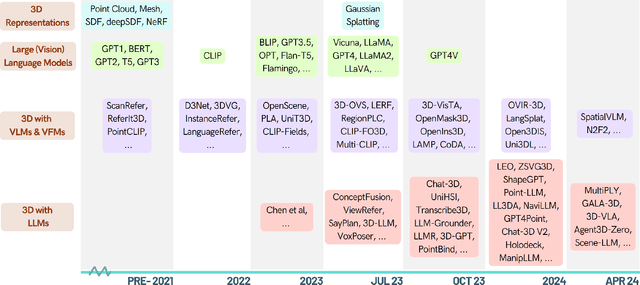
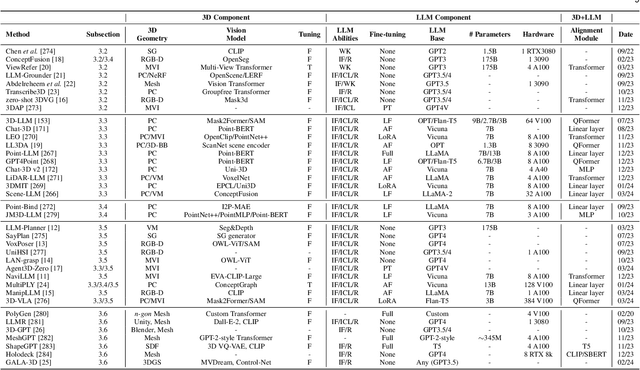

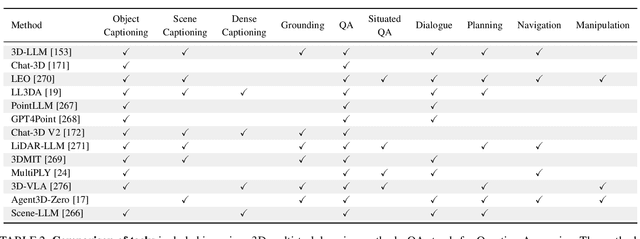
Abstract:As large language models (LLMs) evolve, their integration with 3D spatial data (3D-LLMs) has seen rapid progress, offering unprecedented capabilities for understanding and interacting with physical spaces. This survey provides a comprehensive overview of the methodologies enabling LLMs to process, understand, and generate 3D data. Highlighting the unique advantages of LLMs, such as in-context learning, step-by-step reasoning, open-vocabulary capabilities, and extensive world knowledge, we underscore their potential to significantly advance spatial comprehension and interaction within embodied Artificial Intelligence (AI) systems. Our investigation spans various 3D data representations, from point clouds to Neural Radiance Fields (NeRFs). It examines their integration with LLMs for tasks such as 3D scene understanding, captioning, question-answering, and dialogue, as well as LLM-based agents for spatial reasoning, planning, and navigation. The paper also includes a brief review of other methods that integrate 3D and language. The meta-analysis presented in this paper reveals significant progress yet underscores the necessity for novel approaches to harness the full potential of 3D-LLMs. Hence, with this paper, we aim to chart a course for future research that explores and expands the capabilities of 3D-LLMs in understanding and interacting with the complex 3D world. To support this survey, we have established a project page where papers related to our topic are organized and listed: https://github.com/ActiveVisionLab/Awesome-LLM-3D.
EchoScene: Indoor Scene Generation via Information Echo over Scene Graph Diffusion
May 02, 2024Abstract:We present EchoScene, an interactive and controllable generative model that generates 3D indoor scenes on scene graphs. EchoScene leverages a dual-branch diffusion model that dynamically adapts to scene graphs. Existing methods struggle to handle scene graphs due to varying numbers of nodes, multiple edge combinations, and manipulator-induced node-edge operations. EchoScene overcomes this by associating each node with a denoising process and enables collaborative information exchange, enhancing controllable and consistent generation aware of global constraints. This is achieved through an information echo scheme in both shape and layout branches. At every denoising step, all processes share their denoising data with an information exchange unit that combines these updates using graph convolution. The scheme ensures that the denoising processes are influenced by a holistic understanding of the scene graph, facilitating the generation of globally coherent scenes. The resulting scenes can be manipulated during inference by editing the input scene graph and sampling the noise in the diffusion model. Extensive experiments validate our approach, which maintains scene controllability and surpasses previous methods in generation fidelity. Moreover, the generated scenes are of high quality and thus directly compatible with off-the-shelf texture generation. Code and trained models are open-sourced.
SceneTex: High-Quality Texture Synthesis for Indoor Scenes via Diffusion Priors
Nov 28, 2023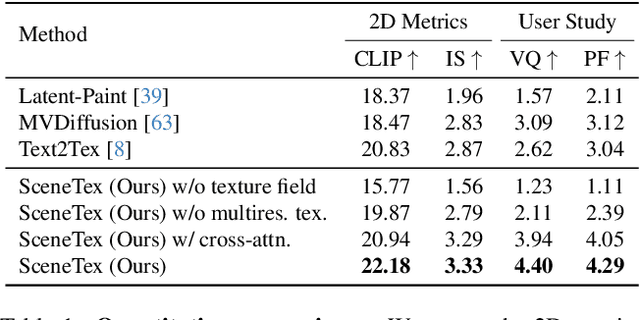

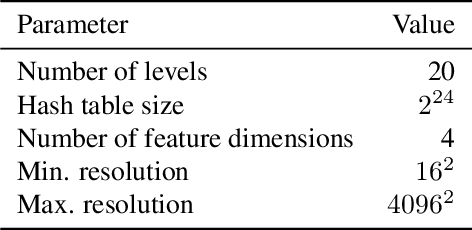
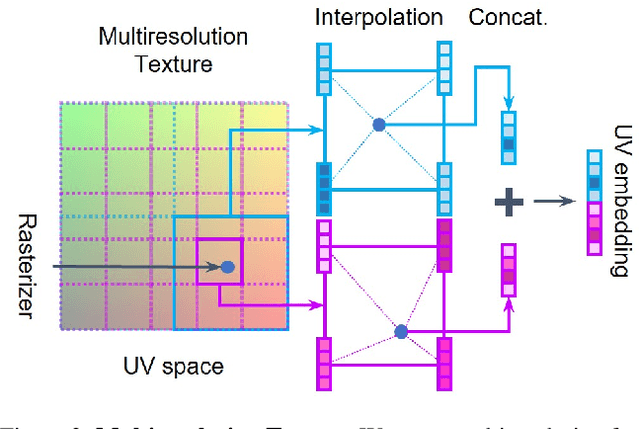
Abstract:We propose SceneTex, a novel method for effectively generating high-quality and style-consistent textures for indoor scenes using depth-to-image diffusion priors. Unlike previous methods that either iteratively warp 2D views onto a mesh surface or distillate diffusion latent features without accurate geometric and style cues, SceneTex formulates the texture synthesis task as an optimization problem in the RGB space where style and geometry consistency are properly reflected. At its core, SceneTex proposes a multiresolution texture field to implicitly encode the mesh appearance. We optimize the target texture via a score-distillation-based objective function in respective RGB renderings. To further secure the style consistency across views, we introduce a cross-attention decoder to predict the RGB values by cross-attending to the pre-sampled reference locations in each instance. SceneTex enables various and accurate texture synthesis for 3D-FRONT scenes, demonstrating significant improvements in visual quality and prompt fidelity over the prior texture generation methods.
Generating Context-Aware Natural Answers for Questions in 3D Scenes
Oct 30, 2023



Abstract:3D question answering is a young field in 3D vision-language that is yet to be explored. Previous methods are limited to a pre-defined answer space and cannot generate answers naturally. In this work, we pivot the question answering task to a sequence generation task to generate free-form natural answers for questions in 3D scenes (Gen3DQA). To this end, we optimize our model directly on the language rewards to secure the global sentence semantics. Here, we also adapt a pragmatic language understanding reward to further improve the sentence quality. Our method sets a new SOTA on the ScanQA benchmark (CIDEr score 72.22/66.57 on the test sets).
Text2Tex: Text-driven Texture Synthesis via Diffusion Models
Mar 20, 2023Abstract:We present Text2Tex, a novel method for generating high-quality textures for 3D meshes from the given text prompts. Our method incorporates inpainting into a pre-trained depth-aware image diffusion model to progressively synthesize high resolution partial textures from multiple viewpoints. To avoid accumulating inconsistent and stretched artifacts across views, we dynamically segment the rendered view into a generation mask, which represents the generation status of each visible texel. This partitioned view representation guides the depth-aware inpainting model to generate and update partial textures for the corresponding regions. Furthermore, we propose an automatic view sequence generation scheme to determine the next best view for updating the partial texture. Extensive experiments demonstrate that our method significantly outperforms the existing text-driven approaches and GAN-based methods.
UniT3D: A Unified Transformer for 3D Dense Captioning and Visual Grounding
Dec 01, 2022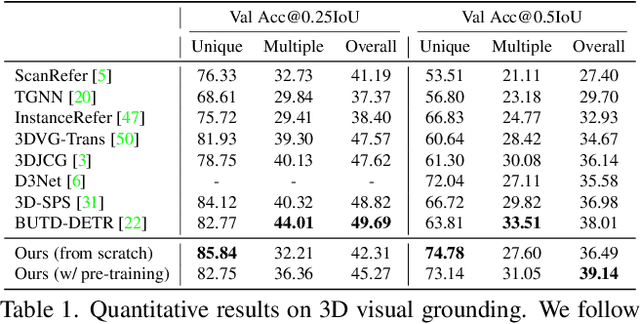
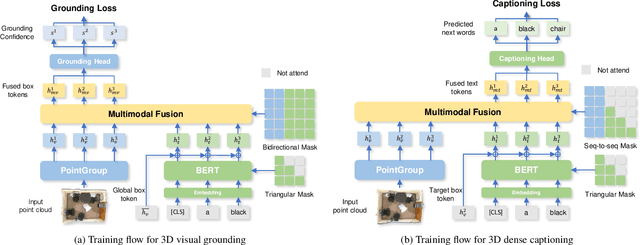

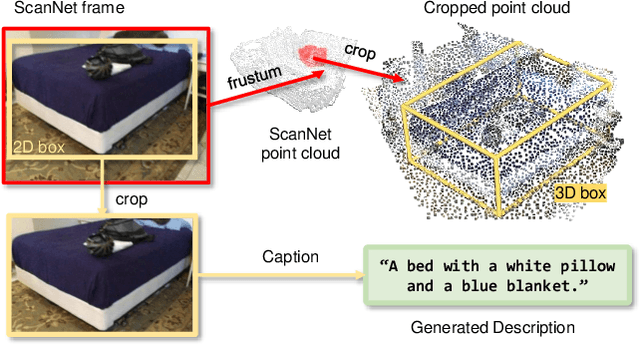
Abstract:Performing 3D dense captioning and visual grounding requires a common and shared understanding of the underlying multimodal relationships. However, despite some previous attempts on connecting these two related tasks with highly task-specific neural modules, it remains understudied how to explicitly depict their shared nature to learn them simultaneously. In this work, we propose UniT3D, a simple yet effective fully unified transformer-based architecture for jointly solving 3D visual grounding and dense captioning. UniT3D enables learning a strong multimodal representation across the two tasks through a supervised joint pre-training scheme with bidirectional and seq-to-seq objectives. With a generic architecture design, UniT3D allows expanding the pre-training scope to more various training sources such as the synthesized data from 2D prior knowledge to benefit 3D vision-language tasks. Extensive experiments and analysis demonstrate that UniT3D obtains significant gains for 3D dense captioning and visual grounding.
Federated Learning via Decentralized Dataset Distillation in Resource-Constrained Edge Environments
Aug 31, 2022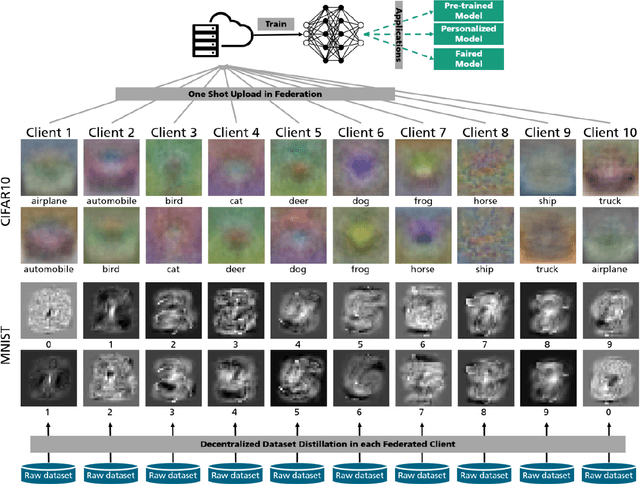

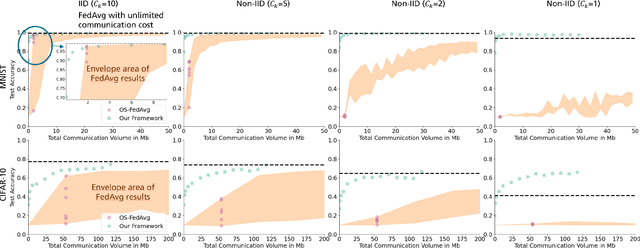
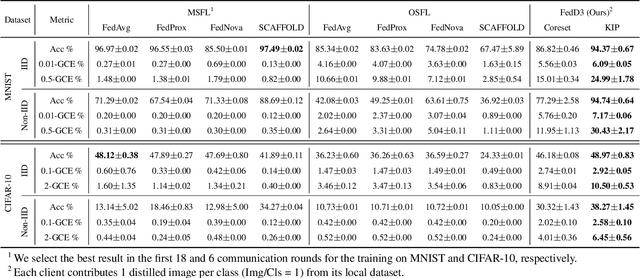
Abstract:We introduce a novel federated learning framework, FedD3, which reduces the overall communication volume and with that opens up the concept of federated learning to more application scenarios in network-constrained environments. It achieves this by leveraging local dataset distillation instead of traditional learning approaches (i) to significantly reduce communication volumes and (ii) to limit transfers to one-shot communication, rather than iterative multiway communication. Instead of sharing model updates, as in other federated learning approaches, FedD3 allows the connected clients to distill the local datasets independently, and then aggregates those decentralized distilled datasets (typically in the form a few unrecognizable images, which are normally smaller than a model) across the network only once to form the final model. Our experimental results show that FedD3 significantly outperforms other federated learning frameworks in terms of needed communication volumes, while it provides the additional benefit to be able to balance the trade-off between accuracy and communication cost, depending on usage scenario or target dataset. For instance, for training an AlexNet model on a Non-IID CIFAR-10 dataset with 10 clients, FedD3 can either increase the accuracy by over 71% with a similar communication volume, or save 98% of communication volume, while reaching the same accuracy, comparing to other one-shot federated learning approaches.
D3Net: A Speaker-Listener Architecture for Semi-supervised Dense Captioning and Visual Grounding in RGB-D Scans
Dec 02, 2021
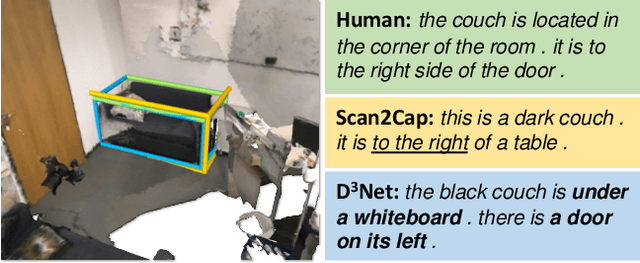
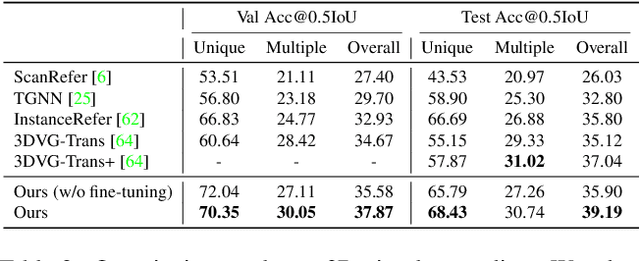

Abstract:Recent studies on dense captioning and visual grounding in 3D have achieved impressive results. Despite developments in both areas, the limited amount of available 3D vision-language data causes overfitting issues for 3D visual grounding and 3D dense captioning methods. Also, how to discriminatively describe objects in complex 3D environments is not fully studied yet. To address these challenges, we present D3Net, an end-to-end neural speaker-listener architecture that can detect, describe and discriminate. Our D3Net unifies dense captioning and visual grounding in 3D in a self-critical manner. This self-critical property of D3Net also introduces discriminability during object caption generation and enables semi-supervised training on ScanNet data with partially annotated descriptions. Our method outperforms SOTA methods in both tasks on the ScanRefer dataset, surpassing the SOTA 3D dense captioning method by a significant margin (23.56% CiDEr@0.5IoU improvement).
 Add to Chrome
Add to Chrome Add to Firefox
Add to Firefox Add to Edge
Add to Edge